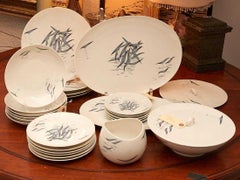Vintage Stamp Vending Machine
Recent Sales
1950s Modern Vintage Stamp Vending Machine
Porcelain
Raymond Loewy for sale on 1stDibs
For those in the know, French-born American industrial designer Raymond Loewy is the “father of streamlining.” He is widely recognized as a pioneer of industrial design consulting — a creative powerhouse who took aim at cluttered designs and simplified them. Loewy left his mark on everything from toothbrushes to trashcans to spacecraft interiors. He designed cars, worked in illustration, and crafted comely dressers and other furniture.
Loewy was born in Paris, France. At age 15, he designed a model airplane that was powered by rubber bands. It won the James Gordon Bennett Cup of 1908. Loewy patented the model kit for this plane by the following year and saw brisk sales. With his savings, Loewy was able to study at the University of Paris and then at Ecole de Lanneau, where he earned an engineering degree in 1918.
Loewy moved to New York City in 1919 and found work as a window designer for the department stores Macy's, Wanamaker's and Saks and as a fashion illustrator for Vogue and Harper's Bazaar. Loewy’s big break in industrial design came in 1929 when he altered the Gestetner duplicating machine — removing jutting parts and encasing the moving works in an understated cover. It caused a sensation within the industry — and companies began to call on him.
Loewy designed packaging for Coca-Cola and revised the look of Lucky cigarettes. The “Loewy Look,” which referred to the designer’s efforts to strip a product of any unnecessary detail and streamline its appearance, began to characterize hundreds of products.
Loewy found clients in a dizzying number of companies. He did everything from retooling logos to redesigning products. His 1934 Sears Coldspot refrigerator was a sleek innovation that broke sales records. His Pennsylvania Railroad locomotive resembled a speeding bullet and was the darling of the 1939 World’s Fair. Loewy even reworked shapes for snacks at Nabisco. By the time World War II gathered steam, Raymond Loewy Associates — the industrial design firm he founded — had been operating in a number of American cities. When Time magazine featured him on the cover in October 1949 — Loewy was not shy about publicity — his profile soared.
Loewy worked with Studebaker for decades. The success of their 1953 Starliner coupe was due to his revolutionary design, while their 1963 futuristic, fiberglass-bodied Avanti, which came with advanced safety features and materialized at a time when the company was experiencing financial hardship, was his crowning achievement for the maker.
Returning to his roots in aviation, Loewy worked for NASA from 1967 to 1973 on the interior design of the Skylab space station. He was also involved in the interior designs of the Concorde supersonic jet and Air Force One. Loewy delighted in creating furniture and collaborated with manufacturers such as Mengel Furniture, Rosenthal and Doubinsky Frères. In the 1970s, Loewy and his wife shuttered their businesses and retired in France.
On 1stDibs, find vintage Raymond Loewy cabinets, serveware, seating and more.
A Close Look at modern Art
The first decades of the 20th century were a period of artistic upheaval, with modern art movements including Cubism, Surrealism, Futurism and Dadaism questioning centuries of traditional views of what art should be. Using abstraction, experimental forms and interdisciplinary techniques, painters, sculptors, photographers, printmakers and performance artists all pushed the boundaries of creative expression.
Major exhibitions, like the 1913 Armory Show in New York City — also known as the “International Exhibition of Modern Art,” in which works like the radically angular Nude Descending a Staircase by Marcel Duchamp caused a sensation — challenged the perspective of viewers and critics and heralded the arrival of modern art in the United States. But the movement’s revolutionary spirit took shape in the 19th century.
The Industrial Revolution, which ushered in new technology and cultural conditions across the world, transformed art from something mostly commissioned by the wealthy or the church to work that responded to personal experiences. The Impressionist style emerged in 1860s France with artists like Claude Monet, Paul Cézanne and Edgar Degas quickly painting works that captured moments of light and urban life. Around the same time in England, the Pre-Raphaelites, like Edward Burne-Jones and Dante Gabriel Rossetti, borrowed from late medieval and early Renaissance art to imbue their art with symbolism and modern ideas of beauty.
Emerging from this disruption of the artistic status quo, modern art went further in rejecting conventions and embracing innovation. The bold legacy of leading modern artists Georges Braque, Pablo Picasso, Frida Kahlo, Salvador Dalí, Henri Matisse, Joan Miró, Marc Chagall, Piet Mondrian and many others continues to inform visual culture today.
Find a collection of modern paintings, sculptures, prints and other fine art on 1stDibs.
- What did Raymond Loewy design?1 Answer1stDibs ExpertFebruary 22, 2021Raymond Loewy is known as the father of industrial design. While he has designed razors, railroad terminals and more, Loewy is well known for notable logos such as the Lucky Strike cigarette packet and Coke bottle.
